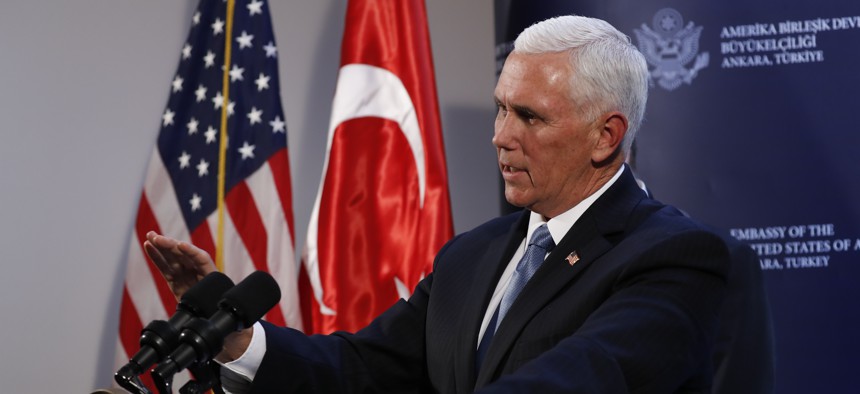
Vice President Mike Pence speaks at the U.S. ambassador's residence during a news conference after meeting with Turkish President Recep Tayyip Erdogan, Thursday, Oct. 17, 2019, in Ankara, Turkey. Pence says the U.S. and Turkey have agreed to a cease-fire. AP Photo
US Agrees to Lift Sanctions on Turkey in Syria ‘Ceasefire’ Deal
“From what I understand it’s not a ceasefire,” Sen Marco Rubio, R-Fla., told reporters on Capitol Hill. “You have one-hundred-and-X number of hours to get out of here before we kill you.”
The United States will remove its three-day-old sanctions on Turkish officials in exchange for a ceasefire that leaves Turkey’s forces in northeastern Syria, the U.S. vice president said Tuesday, essentially acquiescing to Ankara’s bid to sweep formerly U.S.-backed Kurdish fighters from a 20-mile zone along its Syrian border.
Turkish President Recep Tayyip Erdogan has agreed to “pause” his offensive against the Kurdish YPG fighters while the United States “facilitates” their withdrawal from the border zone over the next 120 hours, Vice President Mike Pence told reporters after meeting with Erdogan in Ankara. After the Kurds leave, Pence said, Erdogan will impose a “permanent” ceasefire and the United States will lift sanctions imposed Monday on Turkey’s energy, defense, and interior ministers.
Shortly after Pence's announcement, the commander of the Kurdish fighters, Gen. Mazloum Kobani, said that the group has accepted the ceasefire deal, and characterized it as limited to the territory where fighting has been ongoing.
Related podcast:
Meanwhile, it’s unclear whether the military is prepared to carry out the “facilitated” withdrawal. As of Thursday morning, the United States was in the midst of a risky and hastily-planned withdrawal of hundreds of its own troops across northeastern Syria, and the status of that operation in light of the U.S.-Turkey deal is unknown.
Pence said that the U.S.-facilitated withdrawal “has literally already begun” and that the Kurdish fighters “greatly welcome the opportunity for the ceasefire to make a safe and orderly withdrawal from those areas in the safe zone where they still have a presence.”
“We think the agreement today ends the violence, which is what President Trump sent us here to do and achieve an immediate ceasefire,” Pence said.
The United States and Turkey also agreed to “coordinate” on the detention of thousands of ISIS fighters currently held by the SDF across Syria, Pence said, and “mutually committed to the defeat-ISIS activities in Northeast Syria.”
Trump swiftly celebrated the deal on Twitter, boasting that it will save “millions of lives.”
“This deal could NEVER have been made 3 days ago. There needed to be some ‘tough’ love in order to get it done. Great for everybody,” he wrote. “Proud of all!”
The deal was quickly met by harsh criticism that it does little more than validate Turkey’s invasion of Syria that began last week.
“From what I understand it’s not a ceasefire,” Sen Marco Rubio, R-Fla., told reporters on Capitol Hill. “You have one-hundred-and-X number of hours to get out of here before we kill you.”
Sen. Mitt Romney, R-Utah, said on the Senate floor that "what we have done to the Kurds will stand as a blood stain in the annals of American history."
Turkey also denied that the deal amounted to a “ceasefire.”
Related: US Lawmakers Fear The Damage Is Done On Syria
Related: The US Literally Doesn’t Know How Many ISIS Fighters Have Escaped In Syria
Related: ‘Silent Warriors’ Speak Out Against Trump’s Syria Turnaround
“This is not a ceasefire. We will pause the operation for 120 hours in order for the terrorists to leave. We will only stop the operation if our conditions are met,” Turkish Foreign Minister Mevlut Cavusoglu told reporters.
The YPG put up a stiff resistance to the Turkish incursion over the past week, despite being wildly outgunned. But former military officials tracking the violence saw their withdrawal as only a matter of time.
“I think Kurds will, first of all, defend themselves to the best that they can," former U.S. Central Command Gen. Joseph Votel, who retired earlier this year, said last week. "When it becomes apparent to them that they cannot deal with this very modernized army and the capabilities that Turkey has, then I think they will leave the area."
“Not only will the fighters leave, but I would expect that their citizens would leave as well, with the feeling that they would not be secure remaining in that area,” he said.
Trump has been under fierce fire even from close allies on Capitol Hill who blame him for the Turkish invasion of northeastern Syria. In a phone call with Erdogan on Oct. 6, Trump responded to the Turkish president’s threat of an imminent attack by saying that he would clear U.S. soldiers from a previously negotiated, much narrower border zone — giving Turkey a de facto “green light” to attack the United States’ Kurdish allies, critics say.
Those troops, whose job was to participate in joint patrols with Turkey, were seen as a deterrent against Turkish invasion — not because they would have exchanged fire with Turkey but because Turkey would not want to risk accidentally harming NATO-allied American servicemembers in the course of their assault.
Within three days of the phone call with Trump, Erdogan had launched the first airstrikes. Last weekend, Trump announced a full withdrawal of the remaining thousand troops from Syria, leaving behind the Kurdish fighters who for four years have been battling ISIS with U.S. direction and fending off Syrian President Bashar al-Assad’s forces.
Turkey has repeatedly threatened to attack the U.S.-allied SDF, which is the militia arm of a Kurdish separatist group that Ankara considers to be terrorists. But it had never followed through on those threats until last Wednesday, when it began launching air and artillery strikes into northeastern Syria.
The United States and Turkey over the summer had established a so-called “security mechanism,” designed to address Turkish concerns about the SDF and prevent an attack. The U.S. and Turkish militaries conducted joint patrols and fly-overs on the border of Syria and Turkey, and established a coordination center in southern Turkey. “We were doing all the things we agreed to do,” Defense Secretary Mark Esper said last week.
As part of that security deal, the SDF had complied with U.S. requests to pull back its own defensive fortifications — leaving them vulnerable when Turkey attacked.
Turkey has said that its goals are to clear the wider buffer zone region of Kurdish fighters and to rehome Syrian refugees currently living in southern Turkey. Some U.S. lawmakers and activists have accused Turkey of carrying out an ethnic cleansing operation in Syria.
“We are on the verge of a potential ethnic cleansing, even genocide that will be shameful throughout history,” Sen. Richard Blumenthal, D-Conn., said Thursday morning following a classified briefing with Esper and Joint Chiefs Chairman Gen. Mark Milley.
Pence praised Turkey for agreeing to the deal, which also reaffirms Turkey’s status as a NATO ally.
“Turkey’s willingness to pause and embrace a ceasefire operations enables us to see to that orderly withdrawal,” he said. “You'll be able to see from the agreement itself” what concessions the U.S. gave Turkey.
--This story was updated at 4 p.m. to include the Kurdish response.
NEXT STORY: US Lawmakers Fear The Damage Is Done On Syria




